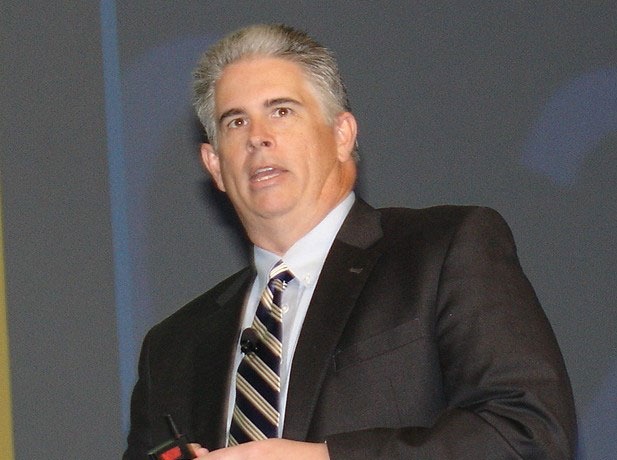Soon to be a larger supply chain provider than either FedEx or UPS, Amazon is putting logistics to use as a “secret weapon,” according to a prominent Wall Street analyst speaking at a Retail Industry Leaders Association forum.
“Amazon is using logistics as a secret weapon,” Ravi Shanker, Morgan Stanley & Co. LLC’s executive director covering the North American transportation industry, said in a presentation at LINK2020: The Retail Supply Chain Conference, held Feb. 23-26 in Grapevine, Texas.

Amazon has found it cheaper to handle logistics itself than using third parties, Shanker said, and, since 2015, has built its own global end-to-end logistics network, replete with its own vans, trucks and aircraft. But, while Amazon already is a licensed non-vessel-operating common carrier, Shanker said he does not see the Seattle-based multinational giant operating its own containerships anytime soon.
Nonetheless, Shanker foresees Amazon offering its logistics infrastructure to other retailers.
Addressing freight costs on a broader level, Shanker said five supply-side catalysts loom to squeeze truck rates in 2020:
- The final electronic logging device mandate, effective in December 2019, which could negatively impact capacity in the low-single-digit range;
- Insurance rate increases taking effect in the first half of the year, which could reduce capacity by at least 3 percent to 5 percent;
- Implementation of the federal Drug and Alcohol Driver Clearinghouse in January 2020, with potential to reduce driver supply by 1 percent to 3 percent in the first year and as much as 10 percent over time;
- The International Maritime Organization cleaner fuels rule, effective Jan. 1, which could end up in a 5 percent to 33 percent increase in diesel prices; and
- California’s Assembly Bill 5, which also went into effect Jan. 1, requiring company workers to be considered as employees, negatively impacting capacity in California and which may set the stage for tougher labor regulations across the nation, potentially making it difficult for owner-operators to stay in business.
Speaking in the same Feb. 25 session, Simeon Gutman, a Morgan Stanley managing director, said freight rate risks extend across all retail categories, with home furnishings and electronics being the most susceptible sectors and apparel seemingly most insulated.
Gutman said he expects consumer spending to be down a bit in 2020 from 2019 but remain high thanks to low interest rates and a healthy employment picture.
“E-commerce is your friend,” Gutman said, pointing out that it now represents 15 percent of total U.S. retail sales, with the toys and games category leading the way with 45 of that sector’s sales coming via e-commerce.
As far as which companies have “best-in-class” supply chains, Gutman pinpointed consumer electronics leader Best Buy Co. Inc., megaretailer Walmart Inc. and home improvement standard-bearer The Home Depot Inc.

In one of the few other on-the-record RILA conference sessions focusing on logistics, Ed Oldham, senior vice president of supply chain at San Diego-based Petco Animal Supplies Inc., cautioned against companies trying to outdo the nation’s biggest retailers but rather to concentrate on enhancing their own competencies by using solid metrics, picking “the right slice” from the vast amount of available data.
“You’re not going to out-Amazon Amazon,” Oldham said. “You’re not going to out-Walmart Walmart.”

Susanna Zhu, vice president of U.S. commercial planning and supply chain operations at The Hershey Co., said one of the things the Hershey, Pennsylvania-based chocolate frontrunner is doing is investing in a highly sustainable cocoa supply chain.
Zhu said Hershey’s kicked off its Supply Chain 2.0 initiative in 2019 with an emphasis on what she termed “smart complexity,” balancing complexity with efficiency while focusing on people, quality, customer service and, last but not least, value.

Supply chain reimagining is also taking place at Denton, Texas-based specialty retailer Sally Beauty Holdings Inc., where a three-tiered transformation plan is helping move the beauty supply firm beyond its traditional brick-and-mortar presence, according to Joe Bowe, the company’s group vice president for supply chain, logistics and real estate.
The three tiers of the plan, Bowe said, are improvement of end-to-end business processes, optimization of network footprint (including with opening of a new Texas distribution center while closing several other hubs) and deployment of enhanced technology and automation.
Leading off the Feb. 25 agenda, Brian Dodge, president of RILA, said tariffs put in place by the Trump administration have thus far cost U.S. retailers $46 billion.




